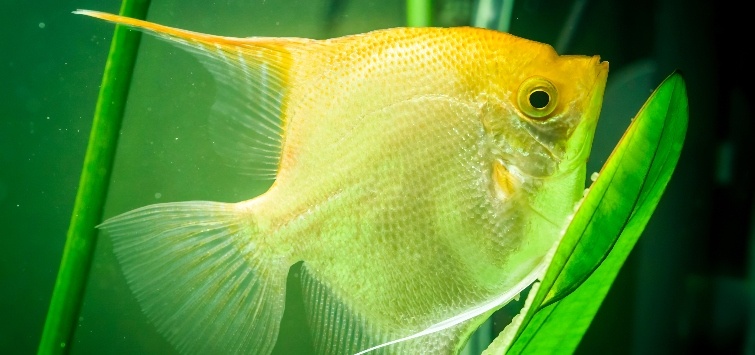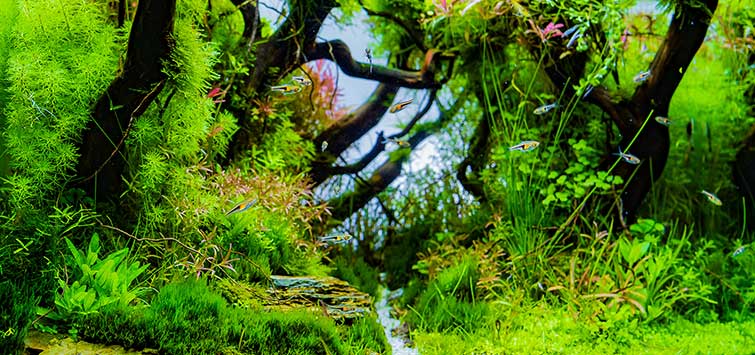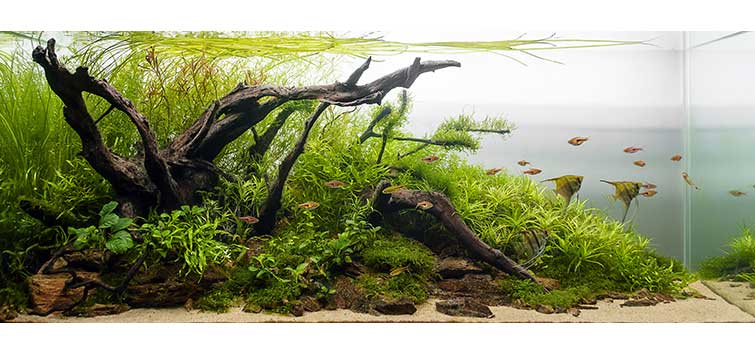Types of Aquarium Plants to Encourage Breeding
Lea Maddocks
Planted aquariums are things of beauty, but they can also be very functional for other aspects of fishkeeping. Most readers and planted tank enthusiasts will know that keeping live plants greatly increases water quality because it helps such things as reducing wastes, providing oxygenation, and keeping the substrate healthy, and also benefits livestock by contributing to a habitat that provides calming shelter and fosters the display of natural behaviors.
Among the behaviors that a carefully planned layout with the best types of aquarium plants can encourage are breeding, spawning, and the successful raising of fry. Indeed, moving parents to spawning tanks and quarantining eggs and fry to raising boxes can often be avoided with proper planning in a planted aquarium. While breeding and fry-rearing environments can be quite different for many fish species, some broad aquascaping guidelines can be useful for several commonly kept categories of fish.
In this column I will outline a few ideas for setting up a planted aquarium that provides an encouraging environment for spawning and raising healthy fry. A planted tank can also be a productive breeding tank!
As fish can have a wide range of needs when it comes to reproduction, I will focus on a narrow range of fish groups that are frequently kept in planted aquariums. Note that each species within these broad groups has specific needs for breeding, spawning, and fry-rearing, so it is strongly recommended to research their particular needs in detail before committing to the plant and layout choices for your tank.
For successful spawning, it is best to keep the target fish as the only fish in the aquarium. If they are small enough to cohabit peacefully with dwarf shrimp, some of these may also be kept in the same tank. Other breeders may have different experiences with shrimp species, but in my own experience and that of keepers I know, red cherry shrimp are useful in turning eggs, removing fungus, and eating dead and unfertilized eggs.
Another tactic that applies to all planted breeding tanks is to understock the tank and oversupply various spawning areas, ensuring that lines of sight between promising spawning sites are blocked. This helps to reduce stress and competition for spawning sites and aids in providing a sense of isolation and safe, private territory for pairs to spawn or guard fry. Again, knowing the specific requirements of your target species, watching the fish’s behavior, and tweaking the layout as needed will give hobbyists the greatest chance of success in developing a long-term breeding and fry-raising planted aquarium.
Types of Aquarium Plants for Egg Scatterers

Egg scatterers common to planted tanks include assorted tetra and small barb species, as well as rasboras, which are the most difficult to spawn. These species generally reproduce with the female scattering a large number of eggs or depositing them onto a soft surface and the male following after her and fertilizing them with milt.
The parents generally exhibit little to no parental care after this act, and the eggs simply sink down to the base (if scattered) and develop over the next few days until hatching tiny fry. These fry are usually not free-swimming, though they may wiggle about when disturbed, until several days later when they start foraging on first foods, usually infusoria, also known as freshwater plankton, such as algae, protozoa, and microscopic multicellular animals.
Spawning areas for these fish should be quiet, dark, and private, not out in the open or frequented by other fish. Densely planted areas with tall, fine-leaved types of aquarium plants are excellent for this, as they create large shaded sections with cloistered areas out of sight of other fish and a multitude of easy entry and exit points.
Fine-leaved and soft plants are also kind to spawning fish that may be actively chasing each other to the point of harassment. These activities can happen in planted areas without creating any injury to the fish, and the twists and turns of many stems and leaves can help a pursued female avoid or escape badgering by males. They can also make it easier for the female to hide and recover after the strain of a successful spawn.
Most aquarists will find that a planted tank with up to two-thirds or three-quarters of the substrate area covered by plants, with deep thickets of varied fine-leaved plants in dense stands, including tall species to provide shaded areas, is conducive for egg-scattering fish to spawn.
When spawning is successful, another complication may arise, however: adults might eat both eggs and fry if they can find them. An aquarium for egg scatterers, therefore, requires a good hiding and development area for the young offspring. A substrate of medium-sized pebbles or a broad mat of dense plant cover, such as moss, shrub-forming plants, or carpeting plants, will allow eggs to sink into cracks and crevices and away from hungry adult fish. As a bonus, the darkness of these areas is also likely to deter fungus growth.
After hatching, fry can also develop safely down among gravel or dark, dense plant bases until they are free-swimming, sheltering there while very small, often attached to an object and hanging. Another advantage of these areas is that they will host abundant infusoria and biofilm as first foods for tiny fry to forage upon in these early days.
Dense, varied cover will assist in hiding newly emerging fish from predatory adults until they are large enough to join the rest of the school. Thankfully, many fry of common egg scatters are free swimming within a few days, so with considerable hiding places and cover—and well-fed adults—there is a good chance many will survive and thrive beyond snack-size.
Types of Aquarium Plants for Livebearers

Livebearers commonly kept in planted tanks include fancy guppies, Endler’s livebearers, platies, swordtails, and mollies. These fish are some of the easiest fish to breed, and they can reproduce in impressive numbers. That said, parents sometimes cannibalize their fry, so more babies will survive with good plant cover and infusoria to feed upon. Adults will also be encouraged to breed more often with ample, dense, and soft cover, and recovering females can seek some shelter from the constantly pursuing males.
For successful breeding of many livebearers, layouts similar to those for egg scatters will work very well. However, the planting scheme can be somewhat more flexible, as fry are born already active, free-swimming, and quite adept at finding cover.
A good mass of mosses or other very dense aquarium plants for fry, or tangles of fine-leaved stem or floating plants, provide good cover and foraging areas, and dense and shaded stands of larger plants that break up lines of sight and offer secluded areas are good for breeding these fish as well.
Types of Aquarium Plants for Angelfish and Discus
Cichlids are a very wide group, and many large cichlids are too destructive for planted aquariums. However, at least two types, angelfish and discus, are very compatible with plants. Both are well suited to fragile planted aquascapes given their flat body shape and slow, delicate movements, and both are egg layers that, while tending to be protective parents, will seldom harm plants as they guard their young.
Regarding layout, again, privacy and suitable territories fitting the adult size of these fish seem to encourage spawning behaviors and provide suitable surfaces on which to lay eggs. Both parent fish select a flat surface to prepare and lay eggs on. Angelfish generally prefer large leaves of plants common to their native waters, such as Amazon swords, but may also lay on any flat, diagonal, or vertical surface, such as a heater or piece of slate. Discus often choose flat stones, wood, or other hardscape, which can be built into the layout for them.
Both angels and discus usually take a few spawns to become good parents, but even with some practice, individuals may still cannibalize their free-swimming fry. Dense cover such as that suggested for livebearers, planted alongside built-in territories and spawning sites, is again the aquarist’s best defense. Tall stem plants and very large thickets are ideal for cover if young fish are left in the spawning aquarium to grow out to size.
Types of Aquarium Plants for Fry
Here is a list of useful aquarium plants for fry sheltering and providing good infusoria-foraging grounds:
Hygrophila spp. (e.g., H. polysperma, H. difformis)
Ludwigia spp.
Egeria densa (anacharis)
Bacopa spp. (e.g., B. monnieri, B. caroliniana)
Ceratopteris thalictroides (water sprite or lace fern)
Ceratophyllum demersum (hornwort)
Azolla spp. (floating water fern)
Lemna minor (duckweed)
Riccia fluitans (crystalwort)
Utricularia gibba (bladderwort)
Hydrocotyle spp.
Limnobium laevigatum (frogbit)
Pistia stratiotes (water lettuce)
Taxiphyllum barbieri (Java moss)
Types of Aquarium Plants for Dwarf South American Cichlids
Dwarf South American cichlids, such as apistos and rams, are also terrific fish for planted tanks. These species show parental care but generally prefer to spawn and raise fry in caves, under driftwood or rockwork, or in other hiding places.
Be sure to include many of those hardscape items in any layout, as well as surrounding or attached plant cover to help fish feel secure in using the site. Once a cave has been chosen and prepared, they will lay eggs on its roof. The female usually remains with the eggs while the male guards the territory around the spawning site.
Females will also shepherd babies around looking for food, and they welcome low-growing types of aquarium plants to forage among. Sturdy plants that mothers and fry can dart into and out of are very useful—epiphytes, crypts, swordplants, and hardy stem plant thickets all work very well to protect the young in their early outings, and dense plantings are also great hunting grounds for tiny first foods.
Experiment for Yourself!
While breeding any species of fish takes experience, practice, and time, the general plant and layout suggestions offered here should provide a good start for setting up a functional and beautiful planted aquarium. As plants are a native feature of many of these species’ habitats, they are highly useful in creating a natural environment that encourages breeding behaviors, provides protection for the babies, and double as sites to grow free, natural first foods for the fry.With some trial and error, and a dose of luck, you can develop a lush planted environment to raise generations of gorgeous fish. Happy aquatic gardening!
See the full article on TFH Digital

.png?h=595&iar=0&w=2781&hash=5FD5E69473BCC22199FBFA2FB71B6033)



